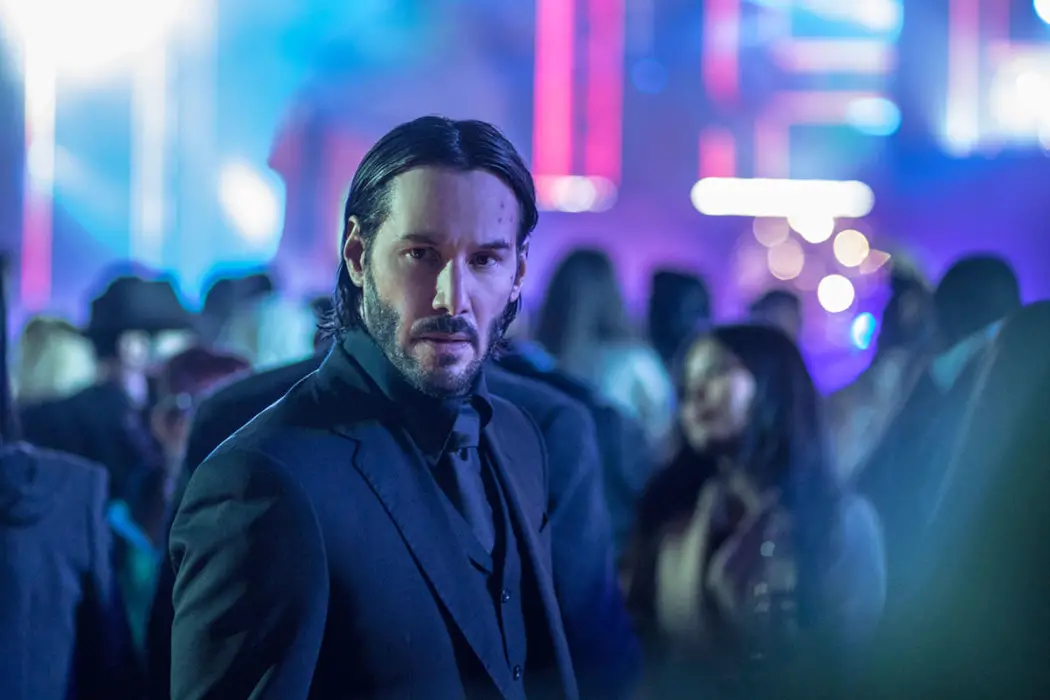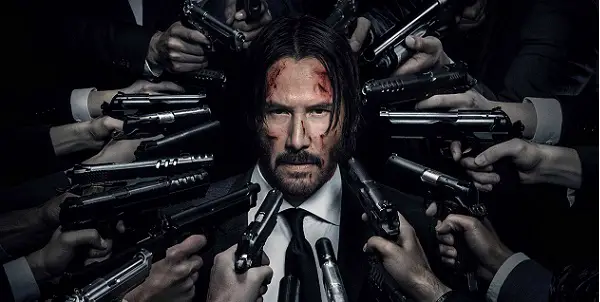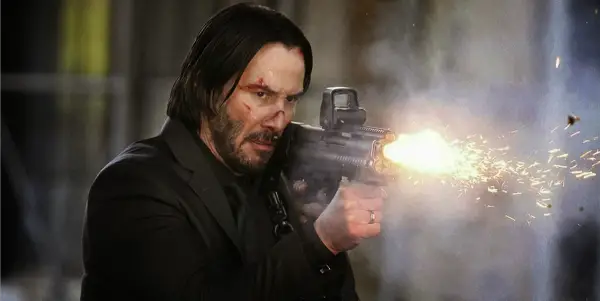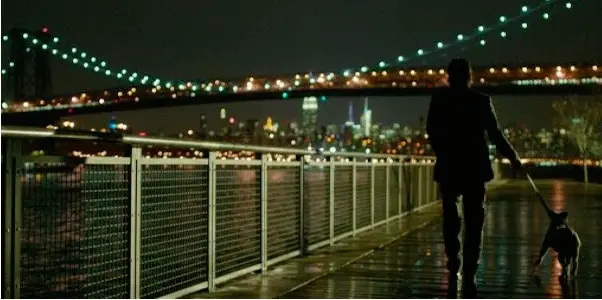JOHN WICK: The Irony & Toll Of Being A Badass

Hazem Fahmy is a poet and critic from Cairo. He…
If you’ve been paying attention, you might say we’re in something of an action film renaissance. In the midst of franchise fatigue and the CGI-ing of everything, a handful of mid-budget, auteurist action films have managed to find quite some success, and it’s highly encouraging. Just this summer, Edgar Wright‘s Baby Driver and David Leitch‘s Atomic Blonde dazzled us with their blood pumping sequences and tight, concise storytelling. Though one can argue that this all began with Gareth Evans’s low-budget international instant classic The Raid: Redemption back in 2011, I’d argue Chad Stahelski’s phenomenal 2014 sleeper hit John Wick, and it’s phenomenal 2017 follow-up John Wick: Chapter 2, gets the credit stateside.
If you’ve seen either of the John Wick films, or know anything about them for that matter, you don’t need me to go on and on about their stylistic prowess, stunning choreography, and dynamic visuals. But I don’t believe breathtaking action was the only impetus behind the Wick films’ unexpected success. Sure, they’re wildly entertaining; beyond refreshing given the recent state of American action cinema, but they also possess a profound emotional and thematic core to them, especially in their brilliant use of irony, that we rarely see in the kinds of films with a John Wick archetype.
Classy Violence
You know when I mean when I say a John Wick archetype. Devilishly handsome. Suave. Deadly. Always in a suit. We know the ins and outs of the gentleman killing machine well by now. Sean Connery laid the groundwork back in 1962. Today, Daniel Craig carries on the legacy while Jude Law and Taron Egerton provide delightful homages/parodies. With Wick, however, Stahelski and Keanu Reeves have given us a poignant deconstruction of that very cinematic trope, in much the same way Doug Liman and Matt Damon tore apart our expectations of the American spy movie with The Bourne Identity back in 2002. Indeed, Wick and Bourne have a lot in common: they’re both remarkably vulnerable as male action protagonists, they’re both haunted by their pasts, and they’re both incredible at fighting. But they are different in one, key aspect: Wick still wears a suit.

Matt Damon’s Jason Bourne was a revolutionary cinematic figure for many reasons, key among them his wardrobe. Since time immemorial, the spy genre had been dominated by the suit. Even more hardboiled spy flicks, like the Michael Caine vehicles Funeral in Berlin and The Fourth Protocol had their heroes dressed to the nines. This is not to mention that spy films that might have broken the fashion convention of the genre, i.e. Brian De Palma’s legendary Mission: Impossible, still featured a quasi-obligatory fancy suit (or in Ethan Hunt’s case, tuxedo) scene. The Bourne Identity’s dismissal of the suit in favor of Bourne’s everyman look was foundational to its departure from the conventions of the spy genre, one that propelled the subsequent films miles beyond the shadow of the Bond franchise.
John Wick’s play with genre and imagery is a bit more complicated, though. Stahelski was as stylistically influenced by the balls to the walls shootouts of Hong Kong action cinema as he was by the Spaghetti Western’s obsession with the lone gunslinger. Both films, and especially the second, use a lot of Bond-esque tropes when it comes to their characters’ obsession with the iconography of wealth, especially as it relates to power. Of course, in this case there is no pesky outsider intruding on the magnificent world of chic villainy. Absolutely everything is underground in John Wick. And it’s a riveting underground at that. Both films have already received heaps of praise for the ingenious level of detail Stahelski put into the Wick-verse, from the illustrious Continental hotel to the dearth of services the assassins’ shiny currency can buy, but there hasn’t been enough exploration of this underworld’s fascinating moral framework.

Aesthetically and logistically, John Wick’s universe shares an intriguing resemblance to Timur Bekmambetov’s, now somewhat forgotten, 2008 Wanted, the lackluster adaptation of Mark Millar’s deeply controversial, but nonetheless powerful graphic novel of the same name. The narrative and thematic difference between the graphic novel and the film is staggering. In place of the source material’s ultra-violent nihilism, Bekmambetov chose to spin a bizarre morality tale; one with a convoluted, and somewhat nonsensical take on fate that attempts to justify our protagonist’s murder-spree. Of course, this façade of morality proves to be nothing but smoke and mirrors by the end, a revelation that leads to the downfall of the inanely titled Fraternity of Assassins.
Honor Among Thieves (and Assassins)
So too does John Wick wrestle with these themes of morality, vengeance, and fate, but in a much more competent and complex way. Second to the action itself, it is here in this pastiche of moral frameworks that the Wick films shine brightest for me. Bond, the archetypical gentleman killing machine, is a man with a strong moral compass who is thrust into an immoral underworld. Bourne is an antihero who steadily grows more and more disillusioned with the treachery and moral failings of his superiors. The Killer’s Ah Jong, a major influence for Stahelski, learns to move away from ruthlessness in favor of tenderness and camaraderie. Wanted’s Wesley is compelled to join an organization because of his belief in its purpose and morality, only to turn on it once he discovers that said purpose and morality were a complete sham. In short, these universes the Wick films borrow from, whether narratively or aesthetically, have a clear moral compass and set of codes, both competent and conventional.

But it’s very hard to put one’s finger on morality in the Wick-verse. At first glance, it might seem as though this is an underworld that is as devoid of remorse and compassion as that of Mark Millar’s original Wanted. These assassins answer to no one outside their world. People are killed left and right without so much as a moment of mourning. Virtually every major character seems to be driven by nothing but an insatiable blood lust. And yet, this is far from an underworld without law. There are strict codes and hierarchies; contracts that must be honored, debts that must be paid back, a certain level of respect that must be granted to established members of the community. So it would seem that the Wick-verse has, if nothing else, a crude justice system; a set of rules and expectations by which members of this society can be held accountable. And yet, this system proves its failure time and time again.
Rules are constantly broken in the Wick-verse. Truces are violated and people get murdered in The Continental. This is especially the case in the second film, a master class of world building that challenges our own understanding of itself before its even over. The plot of Chapter 2 kicks off with Santino’s demand that John honor his blood oath by doing a service for Santino. Due to refusing this demand, John has his house blown up. When he eventually meets with Santino, he learns that the task John must perform is the murder of Santino’s sister, Gianna, a treacherous move that would allow Santino to climb to the highest seat, at the High Table, of the underworld. Thus to “honor” his oath, John must perform a treacherous act, one he inevitably gets betrayed for. This is what I mean by the irony of John Wick, and this is an irony that is absolutely central to the films.
If the John Wick films could have a mantra, it would probably be: violence begets chaos begets a shit ton more violence. For all of their spectacular set pieces, both films ultimately reveal their characters’, even Wick’s, violent exploits to be, at best futile, and at worst, the end of them. There is absolutely no respite. On the one hand this series of consequences is a result of the intricacies of Stahelski’s world, with its rules and systems, but on the other it almost seems to be a matter of self-imposed fate. We see this especially in the dynamic between John and Viggo in the first film. Theoretically, their conflict could have ended with that phone call. Theoretically, they could have talked it out, reached some sort of compromise. But John was simply incapable of that.

In both films, John is driven by vengeance, yet vengeance does nothing for him: no material gain, no promise to a dead loved one kept, not even a moment of sheer catharsis. The excellent morning-after, crying in the bathroom scene from Kill Bill Vol. 2 is nowhere to be seen here. The first film ends with John adopting a new dog. While optimistic, it’s a resolution that renders his rampage somewhat useless. Killing Viggo and Iosef, along with the army that defended them, did nothing but scratch his itch. The second film ends grimly for John. Exiled, alone and hunted, he seems to be locked in a nonstop cycle of ultra-violence, one he clearly wants to get off of, as evidenced by his longing for Helen and his mourning of his New Jersey suburban home, but just can’t seem to do it.
The events of the first film are triggered by an unfortunate happenstance, Iosef’s intrusion upon John’s life, but everything from there is in John’s hands. And it is everything that he does choose that brings about what happens after that. Because he chose to go out of retirement to kill Iosef, he begins a one man war with Viggo that leads to the announcement that he is back in business, prompting Santino to approach him in the second film with his unpaid Marker. No matter how much they try and hide it with their stunning suits, old school courtesy, and luxurious locales, the denizens of the Wick-verse underworld are a vile, violent bunch.
John Wick: Conclusion
Beyond the superb action, it is this subversion of the aesthetic and moral conventions of the action genre that makes the John Wick films so compelling. Before John hangs up the phone on Viggo in the first film, Viggo pleads with him to handle the situation: “like civilized men.” When we cut back to John he is finishing his shower and putting on a suit. Stahelski uses the underworld’s allure of wealth and honor, as well as the films’ breakneck choreography, almost as a trick.
We are invited to cheer for this handsome man in the expensive suits as he brutally dispatches with one fighter after the other. But where does it all leave him at the end? Bond gets to go home with the girl. Bourne frees himself from the shackles of the CIA. Even Ah Jong, despite meeting his demise, gets to redeem himself by sacrificing his life for Jennie. But what does John get? Only more violence.
The opening sequence of the second film ends with a darkly comic moment. After cutting through the men in the chop shop, John confronts Abram Tarasov, the brother and uncle of the two men John had spent the first film hunting. What for a second seemed like an execution quickly turns to a moment of truce. John raises a shot of vodka to Abram and asks for peace. As puzzled as we are, Abram asks: Can a man like you know peace? John simply responds: why not?
If only it were that simple.
What’re your favorite contemporary action films?
Does content like this matter to you?
Become a Member and support film journalism. Unlock access to all of Film Inquiry`s great articles. Join a community of like-minded readers who are passionate about cinema - get access to our private members Network, give back to independent filmmakers, and more.
Hazem Fahmy is a poet and critic from Cairo. He is an Honors graduate of Wesleyan University’s College of Letters where he studied literature, philosophy, history and film. His work has appeared, or is forthcoming in Apogee, HEArt, Mizna, and The Offing. In his spare time, Hazem writes about the Middle East and tries to come up with creative ways to mock Classicism. He makes videos occasionally.













